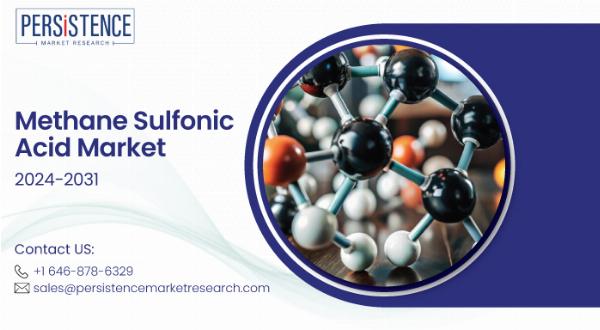Europe’s Methane Sulfonic Acid Market Grows Amid Regulatory Challenges

Strong 8k brings an ultra-HD IPTV experience to your living room and your pocket.
The methane sulfonic acid (MSA) market in Europe is experiencing significant growth despite facing stringent regulatory challenges. MSA is gaining traction as a green, versatile chemical, offering an eco-friendly alternative to traditional acids like sulfuric acid and hydrochloric acid. With its biodegradability and lower environmental impact, MSA is being adopted in industries such as electroplating, pharmaceuticals, and chemical synthesis across Europe. However, navigating the complex regulatory landscape remains a key hurdle for industry players.
In this blog, we explore the growth of the methane sulfonic acid market in Europe, the impact of regulatory frameworks, and how companies are adapting to meet both market demand and compliance requirements.
Methane Sulfonic Acid: A Green Alternative
Methane sulfonic acid (MSA) is a strong, biodegradable acid that has emerged as an eco-friendly alternative to more hazardous chemicals used in industrial processes. Its key applications include:
Electroplating: Widely used in the automotive and electronics sectors to provide corrosion resistance and improve surface finishes.
Chemical Synthesis: A catalyst and reagent in the production of pharmaceuticals, agrochemicals, and specialty chemicals.
Cleaning and Degreasing: MSA is preferred in metal cleaning due to its ability to remove contaminants while being less corrosive than traditional acids.
MSA’s versatility, coupled with its low toxicity and biodegradability, aligns well with Europe’s stringent environmental standards, making it a popular choice in industries seeking sustainable solutions.
Key Drivers of MSA Market Growth in Europe
1. Sustainability and Green Chemistry
Europe is at the forefront of the global push toward sustainability and green chemistry. Companies in the region are increasingly prioritizing eco-friendly materials and processes to meet both regulatory and consumer demands. MSA’s ability to replace more harmful acids while maintaining high performance in applications such as electroplating, cleaning, and chemical synthesis is driving its widespread adoption across multiple industries.
2. Growth in Automotive and Electronics Manufacturing
Europe is home to some of the world’s largest automotive and electronics manufacturers, particularly in countries like Germany, France, and Italy. These industries rely heavily on electroplating to enhance the durability and performance of metal components. MSA has become the preferred choice for electroplating due to its ability to provide high-quality surface finishes while reducing environmental impact. As these sectors grow, so does the demand for MSA.
3. Increasing Demand in Pharmaceutical Manufacturing
The European pharmaceutical industry is another major driver of MSA demand. MSA plays a critical role in the chemical synthesis of active pharmaceutical ingredients (APIs) and other key pharmaceutical compounds. Its efficiency as a catalyst in organic reactions, coupled with its ability to meet environmental and safety regulations, has made it a key component in the pharmaceutical production process.
4. Regulatory Pressures and the Shift Toward Eco-Friendly Solutions
As European regulations regarding chemical use and emissions tighten, industries are under increasing pressure to adopt safer, greener alternatives. MSA’s low environmental impact and compliance with the EU’s REACH regulations (Registration, Evaluation, Authorisation, and Restriction of Chemicals) have positioned it as a valuable alternative to traditional acids, particularly in sectors looking to reduce hazardous waste and emissions.
Regulatory Challenges Facing MSA in Europe
1. Complex Regulatory Environment
While methane sulfonic acid is seen as an eco-friendly alternative to more hazardous acids, the regulatory landscape in Europe is complex. The European Chemicals Agency (ECHA), through REACH regulations, imposes strict guidelines on the production, use, and disposal of chemicals, including MSA. These regulations require companies to demonstrate that their products meet safety and environmental standards before they can be marketed in the region.
For companies dealing with MSA, compliance with REACH is crucial. This process can be time-consuming and costly, particularly for smaller companies without the resources to navigate the regulatory framework. However, compliance is necessary to ensure that MSA is viewed as a safe and sustainable solution for industries across Europe.
2. Cost of Compliance
The cost of meeting European regulatory standards can be a barrier to growth for some companies in the MSA market. From conducting safety assessments to registering chemicals under REACH, the compliance process requires significant investment in both time and money. Smaller firms, in particular, may struggle to absorb these costs, potentially limiting their ability to compete in the European market.
3. Product Safety and Labeling
Product safety and accurate labeling are essential in the European Union, and MSA producers must ensure that their products are properly classified, labeled, and packaged in accordance with EU guidelines. Failure to comply with these regulations can result in penalties, product recalls, or restrictions on market access, posing a challenge for companies looking to expand their footprint in Europe.
How Companies are Overcoming Regulatory Challenges
1. Investment in Compliance
Major players in the MSA market are investing heavily in regulatory compliance to ensure that their products meet European standards. This includes registering their chemicals with ECHA under REACH, conducting thorough safety and environmental impact assessments, and adhering to labeling and packaging requirements. By investing in compliance, companies are not only gaining access to the European market but also positioning themselves as leaders in green chemistry.
2. Partnerships and Collaborations
Collaborations between chemical manufacturers and regulatory consultants are becoming more common as companies seek expert guidance on navigating Europe’s regulatory landscape. These partnerships help streamline the compliance process, reduce costs, and ensure that MSA products meet all necessary safety and environmental standards. Companies that invest in these partnerships are better equipped to succeed in the highly regulated European market.
3. Focus on Innovation and R&D
To overcome regulatory challenges and capitalize on the growing demand for eco-friendly chemicals, companies are investing in research and development (R&D). By improving the performance and safety profile of MSA, companies can create innovative solutions that meet both market demand and regulatory requirements. This focus on innovation is helping MSA producers stay competitive in the evolving European chemical market.
Key Markets for MSA in Europe
1. Germany
Germany, known for its advanced manufacturing sectors, including automotive and electronics, is a major consumer of methane sulfonic acid. The country’s commitment to green chemistry and environmental sustainability has driven the adoption of MSA in electroplating and other industrial processes.
2. France
France’s pharmaceutical industry, one of the largest in Europe, is a key driver of MSA demand. The country’s focus on high-quality, sustainable drug production has led to increased use of MSA in chemical synthesis for pharmaceuticals.
3. United Kingdom
The UK, with its strong presence in both electronics and pharmaceuticals, is another growing market for MSA. Post-Brexit, the UK has implemented its own regulatory framework, but companies looking to export MSA to the UK still need to meet rigorous environmental and safety standards.
Future Outlook for MSA in Europe
1. Growth in Green Chemistry
As European industries continue to shift toward greener and more sustainable manufacturing processes, the demand for eco-friendly chemicals like MSA will only grow. The automotive, electronics, and pharmaceutical sectors are expected to drive further adoption of MSA in the coming years, supported by government policies promoting sustainability.
2. Regulatory Adaptation
While regulatory challenges will remain, companies that invest in compliance and innovation are well-positioned to succeed in the European MSA market. The continued push for environmental responsibility and safety in chemical manufacturing will likely lead to the development of new MSA applications and products tailored to meet European standards.
3. Technological Advancements
Technological advancements in chemical synthesis and electroplating will further support the growth of the MSA market in Europe. Companies that invest in research and development to improve the performance and safety profile of MSA will be at the forefront of innovation, driving growth in key markets.
Conclusion
Europe’s methane sulfonic acid market is growing rapidly, driven by the region’s commitment to sustainability and green chemistry. While regulatory challenges present hurdles, companies that invest in compliance, partnerships, and innovation are well-positioned to thrive. With increasing demand from sectors like automotive, electronics, and pharmaceuticals, the future of the MSA market in Europe looks promising as it continues to align with the continent’s stringent environmental and safety standards.
Note: IndiBlogHub features both user-submitted and editorial content. We do not verify third-party contributions. Read our Disclaimer and Privacy Policyfor details.


